Personal Injury Payouts in Property Settlements
After a couple separates, their assets are divided in a property settlement. This process can be quite straightforward if the assets of the marriage are confined to the marital home, two cars, some furniture and household effects, and two superannuation accounts. In those circumstances, the couple, with the help of their solicitors, should be able to reach a property settlement that is just and equitable without too much delay or expense. Property settlements become more complex when assets include components such as inheritances, trusts, or personal injury payouts. This article examines how the Family Law Act 1975 and case law direct the division of personal injury payouts in property settlements.
Personal Injury Payout as Personal Right
The first step in assessing this particular group of assets for a property settlement is to ascertain whether it is a personal injury payout or merely the right to bring a personal injury claim. In Zorbas and Zorbas (1990), the court found that the right to claim damages in a personal injury case is a personal right. A personal right to claim damages is not considered property for the purposes of asset division.
Personal Injury Payout as Financial Contribution
When a personal injury payout that has been awarded during the course of a relationship, by contrast, it is likely to be considered a financial contribution to the relationship. This was affirmed in Aleksovski v Aleksovski (1996), where a wife’s compensation payout following a motor vehicle accident was deemed to be a financial contribution to the marriage and resulted in a 15% adjustment in favour of the wife in the settlement.
The Five-Step Test
The Federal Circuit and Family COurt (FCFCA) assesses property settlements using a five-step test. The first step in this process is the identification of all assets and liabilities of the couple, including savings, property, mortgages and loans. The second step is to assess whether there needs to be an adjustment of the financial circumstances of the two parties, or whether the current division of assets is sufficient. The third step is to understand the contributions of each party to the total asset pool, from income and savings to non-financial contributions such as childrearing and housekeeping. This category includes contributions such as personal injury payouts received during the relationship. The fourth step is to assess the future needs of each spouse, given their respective ability to earn money in the future, and other factors such as health, age and primary responsibility for children. The fifth and final step in the process is to assess whether the new proposed division of assets is fair and equitable given all the factors under consideration.
Personal Injury Payout as Contribution (Step 3)
A personal injury payout will have the most impact on the final property settlement in cases when the couple has no children, when the payout forms the largest portion of the asset pool, or when the timing of a payout happens before the relationship, during a short relationship, or towards the end of a relationship. If a payout is received early in a long relationship, and where the other party contributes a great deal in the intervening years, then the significance of the original contribution may be eroded. As many common law cases have demonstrated in recent decades, the court finds that an original contribution is less significant not due to the passing of time but due to the effect of contributions of the other spouse over that time.
A court will also take note particularly of how the payout was used. For instance, if the payout was used to acquire and maintain marital assets, such as a home, then this will be considered a significant contribution on the part of the person who was awarded the payout. In regard to personal injury payouts, a counterbalancing contribution might be that the spouse spent time and resources nursing their spouse after the injury.
Consideration of Future Needs (Step 4)
In property settlements that are complicated by personal injury payouts, there is often a consequential impact on the court’s assessment of the future needs of the payee. A significant injury payout will typically mean that the spouse will either need future medical care or will have curtailed future earning potential. This is logical, given that the personal injury payout was probably made in the first instance to account for the future needs of the injured person.
Personal injury payouts are typically considered to be property for the purposes of a property settlement, and an indirect financial contribution from the payee. The specific circumstances of the case need to be considered, and a solicitor with expertise in this field can assist you. If you need advice about a personal injury payout and the implications for a property settlement, please telephone Armstrong Legal on 1300 038 223 or email us to make an appointment.

This article was written by Dr Nicola Bowes
Dr Nicola Bowes holds a Bachelor of Arts with first class honours from the University of Tasmania, a Bachelor of Laws with first class honours from the Queensland University of Technology, and a PhD from The University of Queensland. After a decade working in higher education, Nicola joined Armstrong Legal in 2020.


